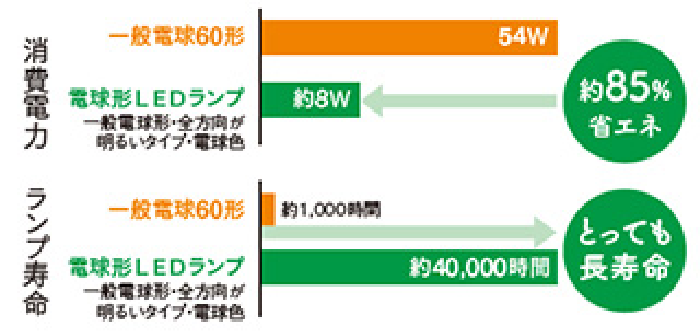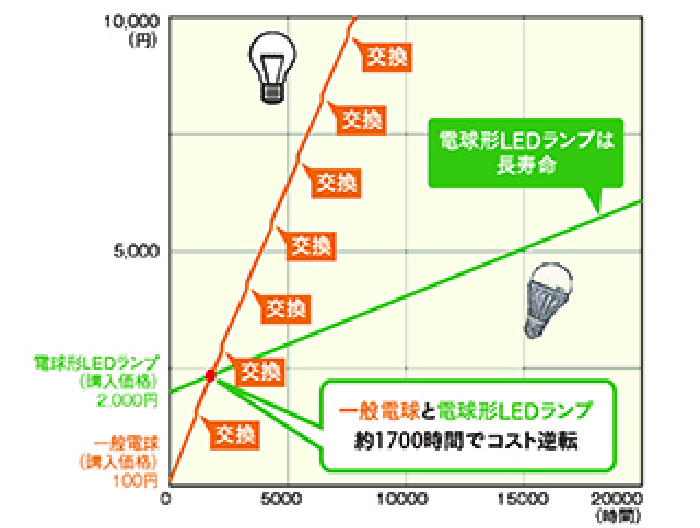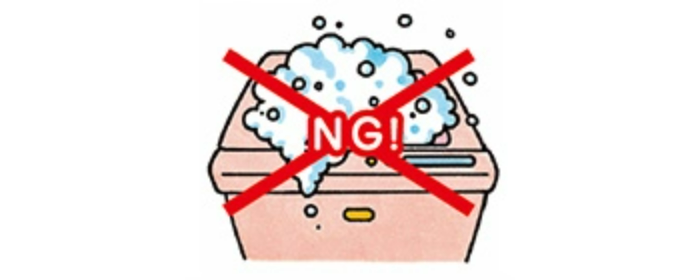Adjust your clothing to set the temperature as close to the outside temperature as possible. Aim for a room temperature of 28°C in summer and 20°C in winter.

Are you using the air conditioner when it's not needed? Use a timer to turn it off earlier when you go out.
- Frequent switching on and off can be counterproductive.
Blocking the heat entering and leaving through windows with curtains, blinds, insulating film, etc. will improve the efficiency of heating and cooling.
When you use an air conditioner in conjunction with an electric fan, the fan's wind spreads cool or warm air throughout the room, so the cooling or heating effect is increased even if you set the temperature lower.

Blocking the outlet or intake with a flower pot, trash can, etc. will reduce energy efficiency.

買い換えるときは省エネ性能をチェック
Choose an air conditioner with a capacity that suits the structure of your home and the size of your room. Before purchasing, check the catalog carefully to see how energy-efficient the air conditioner is. Refer to the "Annual Energy Consumption Efficiency Value (APF)." Choose an air conditioner with energy-saving features that suit the structure and purpose of the room, such as a motion sensor, automatic cleaning function, and airflow control. Also pay attention to how easy the remote control is to use.
Annual performance factor is the value obtained by dividing the heating and cooling capacity required for one year by the amount of electricity consumed by the air conditioner in one year (period power consumption). The higher this value, the more energy efficient the air conditioner is.
|
= |
Total heating and cooling capacity required for one year (kWh) <The number is determined by the capacity of the air conditioner>
Power consumption per period by model (kWh) It is listed in the catalogue |
夏の冷房時の室温は28度を目安に
夏季で電気30.24kWhの省エネ
CO2削減量14.4kg
When the outside temperature is 31°C and the air conditioner (2.2kW) is set to 27°C to 28°C (usage time: 9 hours/day)
約720円の節約
冬の暖房時の室温は20度を目安に
冬季で電気53.08kWhの省エネ
CO2削減量25.2kg
When the outside temperature is 6 degrees and the heating setting of the air conditioner (2.2kW) is changed from 21 degrees to 20 degrees (usage time: 9 hours/day)
約1,270円の節約
冷房は必要なときだけつける
夏季で電気18.78kWhの省エネ
CO2削減量8.9kg
If air conditioning is reduced by one hour per day (set temperature 28 degrees)
約450円の節約
暖房は必要なときだけつける
冬季で電気40.73kWhの省エネ
CO2削減量19.3kg
If heating is reduced by 1 hour per day (set temperature 20 degrees)
約970円の節約
フィルターを月に1回か2回清掃
年間で電気31.95kWhの省エネ
CO2削減量15.2kg
Comparison of an air conditioner with a clogged filter (2.2kW) and one with a cleaned filter
約760円の節約
冷暖房運転期間・運転時間
[Japan Refrigeration and Air Conditioning Industry Association Standard JRA4046: Standard for calculating periodic power consumption of room air conditioners] Operation time: 9 hours/day [Assumed as the average operation time of main functions per day during the period]
Operation period:
Heating period: 5.5 months (October 28th to April 14th) 169 days
Cooling period 3.6 months (June 2nd to September 21st) 112 days Interim period 84 days
LED bulbs, which can replace incandescent bulbs, consume about 1/5 to 1/7 of the power and have a lifespan about 40 times longer.
- There may be variations between products.
- Comparison of power consumption and life span of a regular light bulb and a light bulb-shaped LED lamp that are almost the same brightness

Source: Japan Lighting Manufacturers Association, "Energy Saving Lighting Book for the Home (Published in 2018)"
- Cost comparison of regular light bulbs and LED lamps with roughly the same brightness

Calculation conditions: Annual lighting time: 2,000 hours, electricity cost: 23.97 yen/kWh, power consumption: regular light bulb 54W, light bulb-shaped LED lamp 9W, purchase price example: regular light bulb 100 yen, light bulb-shaped LED lamp 2,000 yen
Source: "Current situation surrounding the LED lighting industry (November 29, 2012)" Created by Kyushu Electric Power based on materials from the Ministry of Economy, Trade and Industry, Commerce and Information Production Bureau, Information and Communications Equipment Division
Turning off lights regularly is the basis for energy conservation, so turn off the lights in rooms where no one is present.
In addition to ceiling lights, use multiple lights in the room to provide different lighting according to different lifestyles and save energy.
When replacing the lamp, please note the following:
- Check the size of the cap, brightness, and light color.
- For sealed fixtures often found in bathrooms, fixtures with dimming functions, and fixtures with insulation, use lamps that are compatible with them.
- The perceived brightness of LED light bulbs varies depending on the product. When selecting an LED light bulb, take into consideration the way the light spreads (all directions, downward, etc.), the number that indicates the brightness of the light source (lumens (lm: total luminous flux)), and the equivalent wattage.
- If you are replacing your light with an LED tube, we recommend replacing the entire fixture to avoid malfunctions.
買い換えるときは
- Use lights with motion sensors for bathrooms, hallways, and outdoor lighting. You won't forget to turn them off, so there's no waste.
- Why not try dimmable lighting in your living room or bedroom? For example, you can set it to 100% brightness when reading, or dim it when listening to music, allowing you to use it according to the situation in your life and saving energy.
- There are many types of LED lighting, including not only dimming, but also color adjustment, clear text, comfortable sleep, and alarm functions. Choose the one that best suits your purpose.
- Check the tatami mat size. For seniors, choose a higher level of brightness.
不要な照明は消す(白熱電球)
年間で電気19.71kWhの省エネ
CO2削減量9.4kg
When the lighting time of one 54-watt incandescent light bulb is reduced by one hour per day
約470円の節約
不要な照明は消す(蛍光ランプ)
年間で電気4.38kWhの省エネ
CO2削減量2.1kg
When the lighting time of one 12-watt fluorescent lamp is reduced by one hour per day
約100円の節約
不要な照明は消す(電球形LED)
年間で電気3.29kWhの省エネ
CO2削減量1.6kg
When the lighting time of one 9-watt LED bulb is reduced by one hour per day
約70円の節約
電球形LEDランプに取り替える
年間で電気90kWhの省エネ
CO2削減量42.8kg
When replacing a 54 watt incandescent bulb with a 9 watt LED bulb
約2,150円の節約
Turn off the TV when you are not watching. When you finish playing games, turn off the TV.
Set your device to power-saving mode, such as by lowering the brightness. If your device has a brightness sensor or auto-off timer, set it to this setting. Cleaning the screen will also brighten it up.
買い換えるときはお部屋に合ったサイズを
- The larger the screen, the more power it consumes. Choose an appropriate size for your viewing distance.
- Check for energy-saving features such as brightness sensors, off timers, power-off when no operation or signal is received, and power-saving features when the lights are turned off.
- Televisions compatible with 4K and 8K broadcasts, which will begin broadcasting in 2018 (note), and OLED televisions will also be available.
(Note) Current broadcasts will continue as usual.
テレビを見ないときは消す(液晶の場合)
年間で電気16.79kWhの省エネ
CO2削減量8.0㎏
If you reduce the time you watch TV (32V type) by 1 hour per day
約400円の節約
画面は明る過ぎないように(液晶の場合)
年間で電気27.10kWhの省エネ
CO2削減量12.9㎏
When the brightness of the TV (32V type) screen is adjusted to the optimum (maximum → center)
約640円の節約
If your device has a low power consumption mode or eco mode, set it to this setting. This will reduce standby power consumption.
Turn off the power when you are not using it. Reviewing the power options settings will also help you conserve energy even if you use it continuously.
Office equipment with the "International Energy Star logo" will automatically switch to energy-saving mode after a certain period of standby time. Look for this logo when purchasing!

使わないときは電源を切る(ノート型の場合)
年間で電気5.48kWhの省エネ
CO2削減量2.6㎏
If you reduce your usage time by 1 hour per day
約130円の節約
電源オプションの見直し(ノート型の場合)
年間で電気1.50kWhの省エネ
CO2削減量0.7㎏
When the power option is changed from "Turn off the monitor" to "System Standby" (3.25 hours/week, 52 weeks)
約30円の節約
There is no need to keep it on "high" all year round. Set the temperature to "medium" or "low" depending on the room temperature and situation. If there is a power saving mode, set it.
Packing it too full will not only impede the flow of cool air, but it will also waste energy by making it take longer to find things and leaving them open for longer periods of time. Organize your items in baskets or trays so they are easy to access.

If you place it too close to the wall, it will not be able to dissipate heat and your electricity bill will increase. Place it at least the distance indicated in the instruction manual. Avoid placing it next to a gas stove or in direct sunlight, and place it in a cool place.
Do not put in hot foods such as barley tea or stew, as this will increase the temperature inside the refrigerator and require extra energy to cool it down.
|
About 5 to 7 degrees |
Vegetable compartment |
Raw vegetables, etc. |
|
|
About 3 to 6 degrees |
Refrigerator |
Long-lasting foods |
|
|
About 0 degrees |
Chilled |
No freezing condition |
Keeps fresher |
|
About -1 degree |
Ice temperature |
||
|
About -3 degrees |
partial |
Slightly frozen state |
|
|
Approximately -18 degrees |
Freezer |
Long-term storage |
|
買い換えるときは家族構成や使い方に合わせて
The amount of power consumption is particularly affected by the size of the freezer compartment. Choose a size that suits your lifestyle and ease of use. Be sure to check not only the annual power consumption, but also the power-saving features and the access route.
ものを詰め込み過ぎない
年間で電気43.84kWhの省エネ
CO2削減量20.8kg
Comparison of full and half full
約1,050円の節約
無駄な開閉はしない
年間で電気10.40kWhの省エネ
CO2削減量4.9kg
Comparison of the results when opening and closing the JIS opening and closing test (note) and when opening and closing twice as many times
約240円の節約
(Note) JIS opening and closing test
The refrigerator is opened 25 times every 12 minutes, and the freezer is opened 8 times every 40 minutes, with each open for 10 seconds.
開けている時間を短く
年間で電気6.10kWhの省エネ
CO2削減量2.9kg
Comparison of opening time of 20 seconds vs. 10 seconds
約140円の節約
設定温度は適切に
年間で電気61.72kWhの省エネ
CO2削減量29.3㎏
When the ambient temperature is 22 degrees and the temperature setting is changed from "strong" to "medium"
約1,470円の節約
壁から適切な間隔で設置
年間で電気45.08kWhの省エネ
CO2削減量21.4kg
Comparison of when the top and both sides are in contact with the wall and when only one side is in contact with the wall
約1,080円の節約
Do you keep the rice you cooked in the morning warm until dinner? It depends on the rice cooker, but if you need to keep it warm for more than 7 to 9 hours, it will be more energy efficient to freeze it in individual servings or cook it in two batches.
Preparing vegetables in the microwave is an energy-efficient way to do this. You can also use the microwave to thoroughly cook baked goods after browning them.
買い換えるときは
炊飯器
Choose the right size for the amount you want to cook!
It is more energy efficient to cook rice in the right size for the amount you want to cook than in a large size for a small amount. Also check out the energy-saving features such as eco-cooking, low-temperature keeping warm, and automatic shutoff of the keep warm function.
電子レンジ
Sensor functions have improved, and some products can heat two items at the same time or control the heat. When choosing a multi-function microwave, be sure to also compare the power consumption of other appliances, such as the oven.
炊飯器の保温時間を短く
年間で電気26.1kWhの省エネ
CO2削減量12.4kg
If the power consumption during warming is 15 watts and the warming time is reduced by 6 hours per day
(Note) Calculation based on 290 rice cooking sessions per year (Kyushu Electric Power own calculation)
約620円の節約
Boil water when you need it and keep it warm at a low temperature. Unplug it when you're not using it. The trend of boiling only the amount of water you need to drink and not keeping it warm has become common.
買い換えるときは省エネタイプを!
There is also data that shows that the annual power consumption of an old-style large pot is greater than that of a refrigerator. Recently, energy-saving pots with a structure that makes it difficult for heat to escape have become mainstream. Let's also compare energy-saving functions such as low-temperature insulation and eco-friendly water boiling.
使用しないときはプラグを抜く
年間で電気107.45kWhの省エネ
CO2削減量51.0kg
A comparison of boiling 2.2L of water in a full pot, using 1.2L, and then leaving it in a "keep warm" state for 6 hours, versus unplugging the pot, re-boiling it without keeping it warm, and using it again.
約2,570円の節約
Adding more than the recommended amount of detergent will not change the cleaning power. In fact, it will take longer to rinse, wasting electricity and water. There are also detergents that only require one rinse.

買い換えるときは消費水量にも注目
Washing machines are home appliances that use a lot of water. Pay attention to the amount of water consumed as well as the power consumption. Using a bath water pump can also help you save on water bills. If it has a drying function, pay attention to the heat pump type, which saves electricity and water! If you mainly dry your clothes indoors and are concerned about humidity and drying time, the blow dryer type is convenient.
洗濯物はまとめ洗いを
It is more effective to wash fewer loads according to the capacity of your washing machine than to wash small loads in several loads.
年間で電気5.88kWhの省エネ
約140円の節約
年間で水道16.75m³の節水
約4,800円の節約
CO2削減量11.0kg/合計約4,940円の節約
Comparison of washing with 40% of the rated capacity (6kg washing and spinning capacity) and washing with 80%
- The CO2 emission coefficient for water use is 0.49kgCO2 /m³ (April 2023) based on the Japan Restroom Industry Association's CO2 conversion coefficient for water.
◎Water 287 yen/m3 [Calculated by Kyushu Electric Power based on water and sewerage charges in the Kyushu area from the Ministry of Internal Affairs and Communications' Retail Price Statistics Survey "Retail Prices of Major Items by County and City" (January 2024)]
Heating the toilet seat and flushing water all year round is a huge waste. Heat them only during the seasons when they are needed. Keep the temperature of the toilet seat and flushing water moderate, and if there is a power-saving mode, turn it on.
買い換えるときはタイプを把握して
- Storage type: A method in which the water in the tank is heated by a heater. Electricity is required to keep the hot water warm.
- Instantaneous type: Water is heated by an instantaneous water heater each time it is used. This consumes less power than the storage type.
- Also check for energy-saving features such as instant heating toilet seats, heated toilet seats, timer power saving, etc. Choose a water-saving model.
使わないときはフタを閉める
年間で電気34.90kWhの省エネ
CO2削減量16.6kg
Comparison between closing the lid and leaving it open (hot water storage type)
約830円の節約
便座暖房の温度は低めに
年間で電気26.40kWhの省エネ
CO2削減量12.5kg
If the toilet seat temperature setting is lowered by one level (medium to weak) (storage type), the toilet seat heating will be turned off during the cooling period.
約630円の節約
洗浄水の温度は低めに
年間で電気13.80kWhの省エネ
CO2削減量6.6kg
When the temperature setting of the washing water is lowered by one level per year (medium to weak) (storage type)
- Heating period: Ambient temperature 11 degrees Celsius Intermediate period: Ambient temperature 18 degrees Celsius Cooling period: Ambient temperature 26 degrees Celsius
約330円の節約
If your heater has a split heating function, make sure it does not heat areas where no one is present.
If you place the carpet directly on the floor, heat will escape to the floor and the heating efficiency will decrease. Place an insulating mat under the carpet to prevent heat from escaping.

cardigan
Knee blanket
socks
買い換えるときはお部屋の広さに合わせて
For "center rugs" that are placed in the center of a room, a rug equivalent to 4 to 6 tatami mats is recommended for rooms of 8 tatami mats or more, 2.5 to 3 tatami mats for rooms of 6 to 8 tatami mats, and 2 tatami mats for rooms of 4.5 tatami mats. Consider the number of people and how you will use the rug, and choose a switching type that suits your home.
広さに合った大きさを
冬季89.91kWhの省エネ
CO2削減量42.7㎏
Comparison between a 3-tatami mat carpet and a 2-tatami mat carpet (5 hours of use per day at room temperature of 20 degrees and with the temperature set to "Medium")
約2,150円の節約
設定温度は低めに
冬季185.97kWhの省エネ
CO2削減量88.3㎏
For a 3 tatami room, when the temperature setting is changed from "strong" to "medium" (5 hours of use per day)
約4,450円の節約
If you use an infrared heater, it will warm up quickly. Be sure to turn it off when you leave.
The heat retention effect is improved, making you warm even at lower temperatures.
買い換えるときは使用人数に合わせた最適サイズを
Check the catalog for power consumption and choose the optimal size according to the number of people using it and the size of the room. Choose one with power saving and timer functions.
こたつ布団に、上掛けと敷布団をあわせて
冬季で電気32.48kWhの省エネ
CO2削減量15.4㎏
Comparison of using only a kotatsu futon and using a kotatsu futon with a cover and a mattress (5 hours of use per day)
約770円の節約
設定温度は低めに
冬季で電気48.95kWhの省エネ
CO2削減量23.3
When used for 5 hours a day and the temperature is lowered from "strong" to "medium"
約1,170円の節約
- The reduction values in "This is what happened when we saved energy! (Reference data for energy saving effects)" were calculated based on the Energy Conservation Center's "Encyclopedia of Home Energy Conservation" and applying Kyushu Electric Power Power's "Smart Family Plan "Power usage charge (unit price of 23.97 yen for 121kWh to 300kWh [as of April 2024]). The CO2 reduction amount was calculated by applying 0.475kg-CO2 /kWh (based on Kyushu Electric Power 's actual value for 2022, reflecting adjustments due to CO2 emission credits and the feed-in tariff system for renewable energy).
This figure does not include Adjustments for fuel costs, etc. or Renewable energy surcharge, but includes the amount equivalent to consumption tax, etc.
